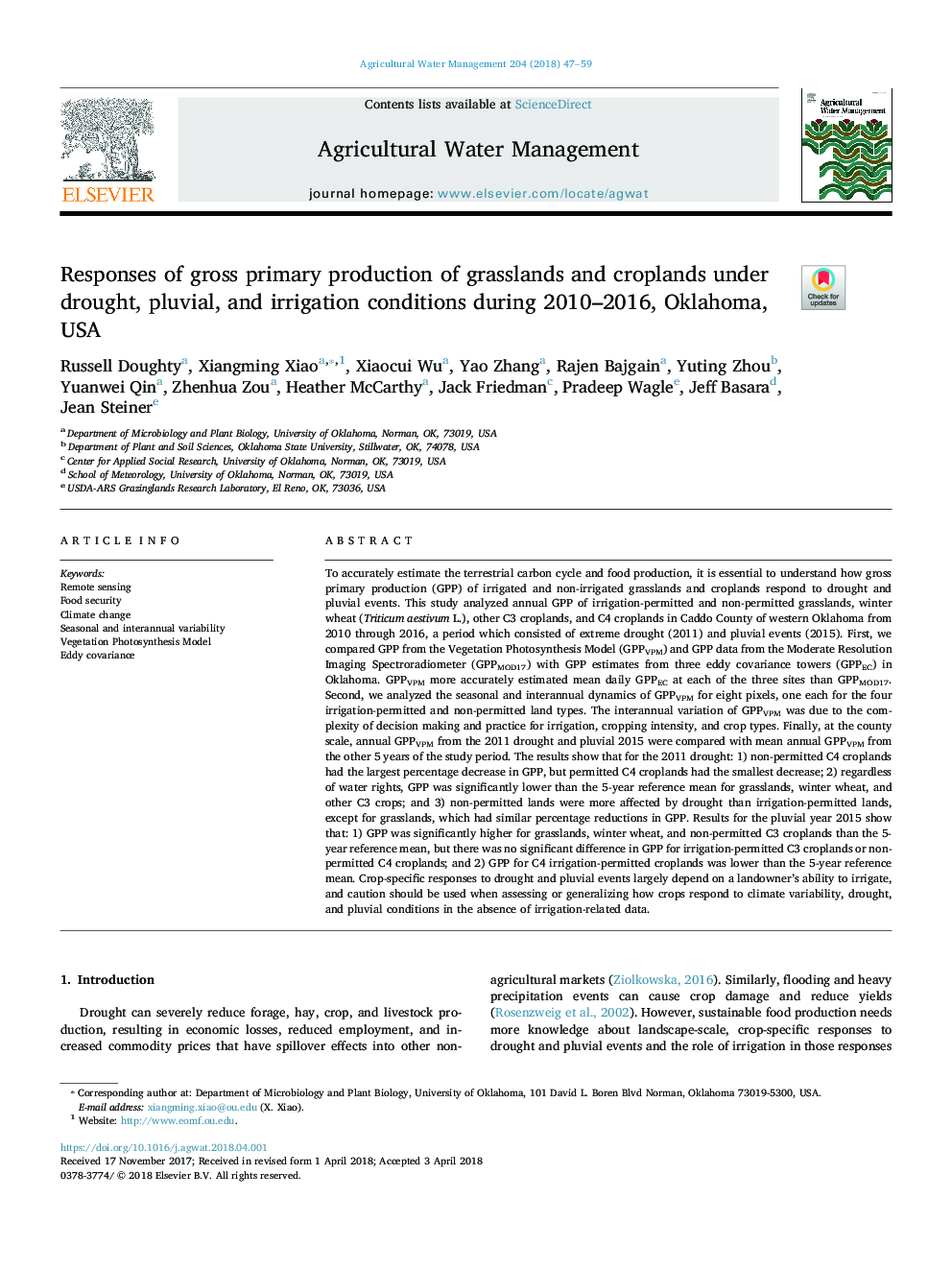| کد مقاله | کد نشریه | سال انتشار | مقاله انگلیسی | نسخه تمام متن |
|---|---|---|---|---|
| 8872880 | 1622876 | 2018 | 13 صفحه PDF | دانلود رایگان |
عنوان انگلیسی مقاله ISI
Responses of gross primary production of grasslands and croplands under drought, pluvial, and irrigation conditions during 2010-2016, Oklahoma, USA
ترجمه فارسی عنوان
پاسخ اولیه تولید ناخالصی های علف های هرز و گیاهان تحت شرایط خشکسالی، پلوتونیوم و آبیاری در سال های 2010-2016، اوکلاهما، ایالات متحده آمریکا
دانلود مقاله + سفارش ترجمه
دانلود مقاله ISI انگلیسی
رایگان برای ایرانیان
کلمات کلیدی
موضوعات مرتبط
علوم زیستی و بیوفناوری
علوم کشاورزی و بیولوژیک
علوم زراعت و اصلاح نباتات
چکیده انگلیسی
To accurately estimate the terrestrial carbon cycle and food production, it is essential to understand how gross primary production (GPP) of irrigated and non-irrigated grasslands and croplands respond to drought and pluvial events. This study analyzed annual GPP of irrigation-permitted and non-permitted grasslands, winter wheat (Triticum aestivum L.), other C3 croplands, and C4 croplands in Caddo County of western Oklahoma from 2010 through 2016, a period which consisted of extreme drought (2011) and pluvial events (2015). First, we compared GPP from the Vegetation Photosynthesis Model (GPPVPM) and GPP data from the Moderate Resolution Imaging Spectroradiometer (GPPMOD17) with GPP estimates from three eddy covariance towers (GPPEC) in Oklahoma. GPPVPM more accurately estimated mean daily GPPEC at each of the three sites than GPPMOD17. Second, we analyzed the seasonal and interannual dynamics of GPPVPM for eight pixels, one each for the four irrigation-permitted and non-permitted land types. The interannual variation of GPPVPM was due to the complexity of decision making and practice for irrigation, cropping intensity, and crop types. Finally, at the county scale, annual GPPVPM from the 2011 drought and pluvial 2015 were compared with mean annual GPPVPM from the other 5 years of the study period. The results show that for the 2011 drought: 1) non-permitted C4 croplands had the largest percentage decrease in GPP, but permitted C4 croplands had the smallest decrease; 2) regardless of water rights, GPP was significantly lower than the 5-year reference mean for grasslands, winter wheat, and other C3 crops; and 3) non-permitted lands were more affected by drought than irrigation-permitted lands, except for grasslands, which had similar percentage reductions in GPP. Results for the pluvial year 2015 show that: 1) GPP was significantly higher for grasslands, winter wheat, and non-permitted C3 croplands than the 5-year reference mean, but there was no significant difference in GPP for irrigation-permitted C3 croplands or non-permitted C4 croplands; and 2) GPP for C4 irrigation-permitted croplands was lower than the 5-year reference mean. Crop-specific responses to drought and pluvial events largely depend on a landowner's ability to irrigate, and caution should be used when assessing or generalizing how crops respond to climate variability, drought, and pluvial conditions in the absence of irrigation-related data.
ناشر
Database: Elsevier - ScienceDirect (ساینس دایرکت)
Journal: Agricultural Water Management - Volume 204, 31 May 2018, Pages 47-59
Journal: Agricultural Water Management - Volume 204, 31 May 2018, Pages 47-59
نویسندگان
Russell Doughty, Xiangming Xiao, Xiaocui Wu, Yao Zhang, Rajen Bajgain, Yuting Zhou, Yuanwei Qin, Zhenhua Zou, Heather McCarthy, Jack Friedman, Pradeep Wagle, Jeff Basara, Jean Steiner,
